Effective monitoring of one’s energy consumption is crucial to being able to identify opportunities for saving energy. And, reducing energy usage can bring significant financial savings. This is especially important now as the UK is facing an energy crisis and businesses across the country are struggling to pay their bills.
Energy management is a growing practice among big businesses that consume a lot of energy. One of the ways to effectively monitor electricity usage and to improve energy management is sub-metering.
Installing sub-meters to track energy use can lead to businesses wasting less energy, improving energy efficiency of their building, lowering operating costs, and improving the comfort of those working at their business premises. Sub-metering can also help companies get closer to meeting their environmental goals and reducing carbon emissions, helping the UK fulfil its net zero ambitions.
Here we explain in detail what sub-metering is and what benefits it can bring to large businesses.
What is sub-metering?
Sub-metering involves installing additional meters that measure energy usage after it reaches the main utility meter. Sub-metering allows monitoring energy usage for individual parts of the building, equipment, or different departments. Thanks to that, companies can check the actual energy usage of various components rather than the business as a whole.
Sub-metering is a great way to better understand how energy is consumed at the business premises. This then allows businesses to make informed decisions about energy use and to determine where improvements are needed.
What are the benefits of sub-metering?
The main benefits of sub-metering include:
- Accurate energy monitoring
- Insights into real-time energy consumption
- Informed decisions about energy use
- Optimised energy performance
- Comparison of energy usage across different parts of the business
- Less energy waste
- No estimated meter readings
- Early warning system about needed maintenance and repairs
All these things can help businesses consume less energy, which translates to financial savings. The money they save on energy bills can be invested into their growth.
‘Sub-metering is growing in popularity, as a method that gathers more granular energy consumption information about a business or site, pinning down the energy usage across different areas of buildings and pieces of equipment. This also often acts as an early warning system, for any equipment that may need maintenance, helping to keep your business running as efficiently as possible,’ Shayne Wilson, Head of EMS Sales at Pilot Group tells Energy Digital.
How to prepare a sub-metering plan?
Before having sub-meters installed, companies should prepare a sub-metering plan allowing them to maximise the chances of the sub-metering project being effective.
When preparing the plan, businesses should do the following:
- Think about what their goals and objectives are
- Establish a budget for the project
- Identify aspects such as size and function of the building, heating and cooling systems, etc
- Select the equipment that supports the metering objectives
- Integrate sub-meters with the building system (after the installation)
- Think about how they will be collecting data from sub-meters
Sub-meters can only be effective in helping companies reduce their energy consumption and save money if businesses regularly collect and analyse data from them. Rather than using sub-meters only to monitor the energy usage, companies must use the data to identify opportunities for reducing energy consumption. And, they must put relevant energy efficiency strategies in place.
What organisations use sub-metering?
Sub-metering can be beneficial for all types of large commercial energy consumers. However, the main kinds of organisations that use sub-metering are:
- Commercial Landlords billing Tenants
By installing sub-meters in the building, landlords can verify how much energy each of the tenants consumes. That saves them the trouble associated with having to divide the total utility bill. And, as sub-metering allows for accurate energy monitoring, landlords do not have to worry about tenants complaining about being overcharged for their energy use.
- Tenant being billed by Commercial Landlords
Just like sub-metering is beneficial to landlords, tenants can also make great use of it. Thanks to sub-metering, they can be sure that they are being billed fairly and that the landlord only charges them for the energy they actually use. Sub-metering also allows them to monitor their carbon footprint and reduce their energy usage. This can result in them reducing their energy bills.
- On site generation
Those who wish to enter into a capacity market agreement for sites generating energy but cannot use the existing fiscal meters can use the sub–metering instead. This is because sub-metering allows them to make sure that each of the individual assets installed meets the relevant standards.
- Commercial and industrial customers
Large commercial and industrial energy consumers can use sub-metering to better understand where energy is being used. This allows them to introduce changes designed to reduce energy consumption in certain parts of the building or by certain departments. In turn, they can reduce the costs and lower their CO2 emissions.
- Manufacturing customers
Large industrial companies that specialise in manufacturing tend to run a lot of energy-intensive operations. By using sub-metering, they can monitor the quality of their power supply and they can easily identify equipment that needs maintenance or repairs. Overall, sub-metering helps them ensure that all operations run smoothly, that there are no disruptions, and that any issues are dealt with quickly.
What features of sub-meters to consider when considering installation?
When considering installation of sub-meters at their premises, businesses should consider the following features:
- Communication method
- Data output
- Frequency of data collection
- Accuracy
- Data storage
- Data display
- Measured data
- Interoperability between different systems
- Number of features
Sub-meters with more features and a local display tend to be more expensive.
Why is energy management and measurement important?
Businesses across the UK have faced an average gas bill increase of more than 250% over the past year, according to energy analysts from Cornwall Insights. As the energy crisis continues, experts predict that energy bills can get even more expensive.
One way to keep energy bills low in these challenging times is to decrease business energy consumption. This is where energy management and measurement comes in.
To be able to undertake steps to reduce business energy consumption, companies must know how much energy they consume and which of their operations are the most energy-intensive. This is especially important in large businesses that have several different departments that might be using different amounts of energy.
Improving energy efficiency must start with knowing how to effectively monitor energy consumption. The best way to ensure accurate measurement of energy use is to get a smart meter. They automatically send readings to suppliers and provide insights into real-time energy consumption. And, for big companies, sub-metering might be the key to success.
‘It’s vital that businesses consistently monitor and measure their energy usage, a process that is easy to set up for those who don’t already have it in place. The more energy data you have, the more detailed your energy profile will be. By utilising this data to plan your business operations more efficiently, this will not only reduce your carbon emissions, but will hugely impact profit margins,’ Wilson says in the conversation with Energy Digital.
Frequently Asked Questions
Can I get sub-meters if I have a prepayment meter?
The simple answer to this question is: yes. If the primary meter is either a post paid meter or a prepayment meter, there are no obstacles to you getting sub-meters.
Post paid meters are also referred to as conventional meters. If you have one, you pay for the energy you consume after you use it.
With prepayment meters, on the other hand, you purchase energy first, load it into the meter, and then use it. This means that you are using a pay-as-you-go method. Your prepayment meter counts down and when it reaches zero, your supply is shut off until you top up again.
Should I use sub-metering?
Whether you should use sub-metering depends on your average consumption and the way the energy is used at your premises. Sub-metering is typically used by large companies that consume a lot of energy across different departments, rooms, or by different individuals living in the building.
If you need advice regarding sub-metering, get in touch with us. We have expert knowledge of the energy industry and we work with industrial companies so we can analyse your energy-consumption habits and help you determine whether sub-metering can be beneficial for your business.
Do sub-meters replace the main meter?
Sub-metering involves installing additional meters downstream of the main utility meter. This means that sub-meters are added to the premises but they do not replace the primary meter that was there before.
And, one of the advantages of sub-meters is that, just like primary meters, can be either a post-paid (usually read each month) or prepaid (have to be topped up whenever consumers use all the credit).
Do sub-meters reduce energy consumption?
Unfortunately, sub-meters themselves do not reduce energy consumption of businesses that have them installed. Sub-meters are a tool that can help companies get a better understanding of how much energy they consume. Based on data obtained using sub-meters, businesses can identify opportunities for reducing their consumption. However, is up to them to undertake concrete actions to use less energy.




